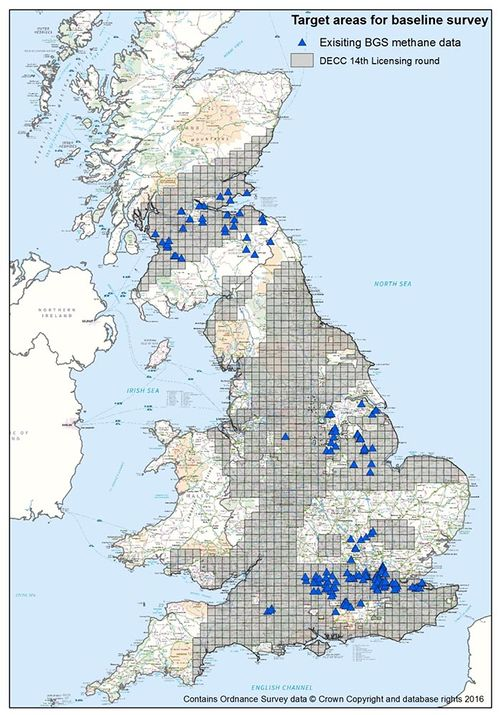OR/15/071 Introduction
| Bell, R A, Manamsa, W G K, and Dochartaigh, B É Ó. 2015. The baseline concentrations of methane in Great British groundwater - the National Methane Baseline survey. British Geological Survey Internal Report, OR/15/071. |
Methane, CH4, is ubiquitous in the environment, including groundwater in which it is commonly found at trace concentrations. Methane is released both by natural processes and anthropogenic activities. While it has no known effects on human health, its presence at high concentrations can lead to explosions under specific conditions in confined spaces. It is also a significant greenhouse gas with a warming capability almost two orders of magnitude higher than carbon dioxide.
Evidence from the USA has shown very high methane concentrations in some aquifers in areas where shales are being commercially exploited for gas. However, there is considerable uncertainty and argument over the source(s) of methane and how it has entered the aquifers, either through natural processes or anthropogenic impacts. Crucially, there was no consistent collection of baseline data on methane concentrations in groundwater in the USA before shale gas exploitation began, making it difficult to correctly identify and attribute the reasons for the existence of the high-methane groundwaters.
The need for a methane baseline in the UK was recognised in the 2012 report on shale gas extraction published by the Royal Society and Royal Academy of Engineering. The methane baseline is defined for this project as the background range of methane concentrations in British groundwaters before any significant exploitation of unconventional hydrocarbons, such as shale gas, has taken place. It should be noted that the measured dissolved methane may not necessarily originate naturally from geological sources — in some cases it may have been produced or released because of human activities such as coal mining or landfill operations. It may also simply result from equilibration between groundwater and the small amount of methane in the atmosphere (currently ~1800 parts per billion by volume).
The British Geological Survey (BGS) has since 2011 been surveying the current distribution of methane concentrations in Great British (GB) groundwater, focusing on areas where aquifers are underlain by shale units that may have shale gas potential. The National Methane Baseline Survey (hereafter the ‘Survey’) will provide a dataset against which any future changes in groundwater methane concentrations can be compared. The Survey builds on previous methane- related work by BGS but has widened the scope both geographically and in terms of aquifer type. It is likely to be of particular interest to energy companies, the general public and environmental regulators, but also to environmental researchers more generally.
Project background
The British Geological Survey (BGS) has been studying methane in GB groundwaters since the 1980s to investigate the potential for methane emissions from groundwaters, and sources of and hydrogeochemical controls on methane. Before the start of the current survey, BGS held some 170 analyses of methane in groundwaters from aquifers across GB, almost all separate sites sampled only once, at various times over the past three decades (Figure 1). Most of these have been reported in scientific publications (principally Darling and Gooddy (2006))[1] or in project reports (e.g. Ó Dochartaigh et al., 2011[2]). In this dataset, 99% of samples show methane concentrations of less than 500µg/l and the remaining 1% have concentrations between 500 and 1680µg/l. These samples were collected using the same sampling procedures and analysed by the same method as for the current survey. These data have been combined with new Survey data.
Following on from this previous work, the BGS commenced the new Survey in November 2011 to determine the concentrations of methane in groundwaters of specific aquifers overlying potential shale gas source rocks. The present report serves as an extension to the report of Stuart (2012)[3] who reviewed the potential risks to UK groundwater from the exploitation of shale gas, and as an update to Ó Dochartaigh et al. (2013)[4].
The Survey is designed to supplement existing BGS groundwater methane data discussed previously to collectively create a nationwide baseline of methane concentrations in areas underlain by formation of potential unconventional hydrocarbon interest. The existing data available before the project began is shown in Figure 1, along with the areas that were made available in 2014 as part of the Department of Energy and Climate Change (DECC)[5] 14th Licensing round.

Contains public sector information licensed under the Open Government Licence v3.0.
This Survey focuses on assessing the methane concentrations in aquifers lying above zones of mature shale gas rock and in areas where exploration is a possibility. The baseline will be an important resource against which future groundwater quality can be compared, especially with regard to methane, but also for inorganic chemical quality which is an integral part of the present survey. This will permit an assessment of any impacts of shale gas exploitation on the water quality of relevant aquifers. For the purpose of this baseline the origin of the methane is of secondary importance. It may be naturally occurring or introduced by human activity such as coal mining and landfills.
References
- ↑ DARLING, W G, and GOODDY, D C. 2006. The hydrogeochemistry of methane: Evidence from English groundwaters. Chemical Geology, Vol. 229, 293–312.
- ↑ Ó DOCHARTAIGH, B É, SMEDLEY, P L, MACDONALD, A M, DARLING, W G, and HOMONICK, S. 2011. Baseline Scotland: groundwater chemistry of the Carboniferous sedimentary aquifers of the Midland Valley. British Geological Survey Open Report OR/11/021.
- ↑ STUART, M E. 2012. Potential groundwater impact from exploitation of shale gas in the UK. BGS Internal Report (unpublished), OR/12/001.
- ↑ Ó DOCHARTAIGH, B E, STUART, M E, BELL, R A, STRUTT, M H, DARLING, W G, and WARD, R S. 2013. Baseline survey of methane in UK groundwaters: interim report, November 2011 to March 2013. British Geological Survey Internal Report, IR/13/016.
- ↑ DECC. 2010. The unconventional hydrocarbon resources of Britain’s onshore basins — shale gas. Department of Energy and Climate Change, London, UK.